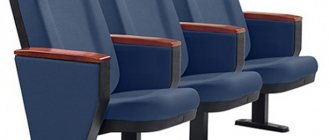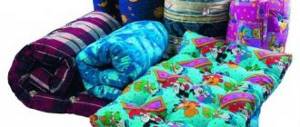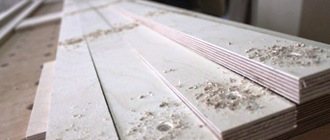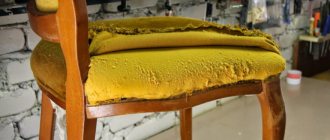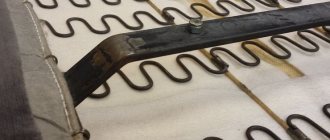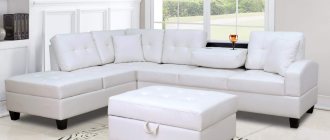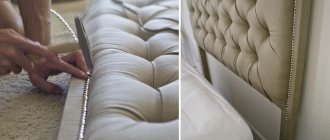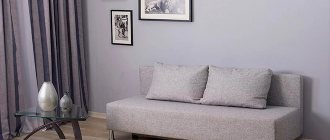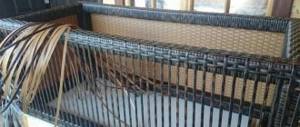This is polyurethane foam - a plastic foam that is 90% air. The material began to be called this way in Soviet times, after the name of the Norwegian supplier Porolon.
The first foam rubber appeared in Germany in 1941, when they studied the foam that is obtained in the manufacture of hard plastic. At first, foam formation was considered a negative process because it prevented the production of dense polyurethane without air. Then they figured out how to benefit from the negative process. Since 1954, the Bayer company began producing foam rubber for stuffing furniture and toys, insulation, making sponges, and as packaging material.
The first foam rubber was short-lived - it quickly lost its elasticity, crumbled - and easily ignited. Now they add special mixtures that prevent ignition.
Foam rubber brands
Defined by three properties:
1. Density - the amount of polyurethane in one cubic meter.
2. Stiffness - the force required to compress the foam by 40%.
3. Residual deformation - the ability of foam rubber to retain its shape. The material is placed in conditions of the desired temperature and humidity, compressed by 50% and measured to what extent the material has deviated from its original shape.
The letters indicate the type of material, and the first two numbers after the letters are the density, the second are the hardness.
For stuffing furniture armrests, seats, headrests
HS - soft and super soft
For sponges, rollers
For seats, mattresses
HR - highly elastic, with added latex
For high quality furniture, orthopedic mattresses
LR - soft, elastic. Distributes the load over the entire plane
In medicine for burn pads
RTC - reticulated (open cell)
For the manufacture of filters, ear pads, sponges, rollers
Hard foam rubber with a density of 40 kg per m3 and a hardness of 65 newtons per meter
Selection rules
Before choosing a filler for upholstered furniture, it is important to decide what kind of product it is. If foam rubber is selected for a sofa, pay attention to the markings with density indicators from 28 kg per cubic meter and higher. If you purchase less dense material, there is a risk that the sofa will not last long.
- check the thickness of the foam; for upholstered furniture it should be at least 3 cm;
- find out about the rigidity and elasticity of raw materials: a stiffer option is suitable for seats than for filling headrests or armrests;
- some types of foam rubber do not hold their shape at all, which indicates their low quality, so check this criterion in the store to make sure the reliability of future furniture;
- ask what additives were used in the production of raw materials to prevent allergies to certain substances, especially when it comes to children's furniture.
Pay attention to the markings; they will help tell you a lot of information about the chosen foam rubber. You should not save on filler, because high-quality material is the key to a long service life of furniture.
Types of foam rubber
Leaf - rectangular in shape, 5–1000 millimeters thick. Suitable for thermal insulation.
Rolled - of different widths and thickness up to 30 millimeters. May be lined with fabric or synthetic materials. Suitable for lining furniture upholstery, car seats, and thermal insulation.
Block (molding) - different shapes. Used for toys, rollers and sponges, packaging fragile items.
Acoustic - with and without relief. Needed for sound insulation.
Acoustic foam rubber with relief
White foam rubber turns yellow from the sun, but does not lose its qualities - if possible, cover it with material that does not transmit ultraviolet radiation.
Alexandra Timochkina Author of the article
Alexandra Timochkina Author of the article
In modern production of upholstered furniture it is almost impossible to get by. But here the obvious question arises, what is better, foam rubber or without the use of foam rubber.
Polyurethane foam? Many people say that polyurethane foam (PPU) is better, they say it has a “crust” thanks to which it lasts longer and is harder to the touch, but we dare to disappoint you, both foam rubber and polyurethane foam are the names of the same product. Its correct name is certainly polyurethane foam, and the name foam rubber stuck to it quite a long time ago, back in the 50s, when the only supplier of polyurethane foam was. But now all this is long in the past and it is much more convenient for us to call foam rubber foam rubber.
Now on the Russian market there are quite a lot of companies involved in the production of foam rubber, but they mainly produce lightweight foam rubber, the density of which is less than 25 kg/m3. This type of foam is much easier to produce and transport. But it cannot be classified as furniture. The World Association recognizes foam rubber as furniture if its density is not lower than 25 kg/m3. Foam rubber of lower density is classified as soundproofing or packaging, although it can also be used to create elements of upholstered furniture that are not subject to stress. You can buy furniture foam rubber in Moscow from one sheet in our online store.
What is the difference between foam rubber and polyurethane foam?
Several decades ago, it supplied high-quality elastic material to the territory of the USSR, which was used in construction for insulation and sound insulation, and was also actively used in industry for stuffing armchairs, sofas and other furniture. Because of the name of the supplier company, the material received the common name “foam rubber,” although it was nothing more than soft polyurethane foam. In terms of their chemical composition and structure, polyurethane foam and foam rubber are the same. But traditionally, foam rubber in Russia is more often called filling for furniture and mattresses, and rigid brands of the same material are usually called “polyurethane foam.” Taking into account this informal classification, let's look at how foam rubber actually differs from polyurethane foam.
Which one is used?
The material is used in a variety of fields and selected for different needs according to certain characteristics. For mattresses, the density of foam rubber is important; the service life of the product depends on it. They use polyurethane foam with a density of 25 to 40 kg/m3. The density is indicated by two numbers after the two letters in the name, the next two numbers indicate the hardness index.
Mattresses are made from the following types of foam rubber:
- Standard PPU . The brand is designated ST.
With increased rigidity. Its designation is EL. A popular suggestion is the EL2240 brand. This is a budget option; you shouldn’t expect longevity from such a mattress; it will only last about five years. The EL2540 will last a couple of years longer, but the EL2842 can remain in good condition for ten years.
- The brands HR and VE denote latex foam; such foam is used for sofas and other luxury furniture. You can purchase such foam rubber for furniture at Leroy Merlin. This type of foam is also used in thin orthopedic sofa mattresses.
Structure
Foam rubber is an elastic polyurethane foam with an open-cell structure. Open cells provide good air and moisture permeability. The elasticity or rigidity of polyurethane foam is achieved through the use of different types of polyol in the composition. Whether polyurethane foam or foam rubber, the general composition of the mixtures for their production will be the same, but specific types of the same component (polyols) provide different stiffness characteristics of the material. This is what elastic polyurethane foam used for furniture padding looks like:
And this is hard polyurethane foam, which is used for highly effective thermal insulation:
Advice from a professional
To avoid confusion when ordering thermal insulation, remember - polyurethane foam and foam rubber are the same thing. It is used to insulate rooms using the spraying method. Thanks to low polyurethane foam, it provides the most effective insulation of premises
The conclusion is simple: foam rubber and polyurethane foam are the same material, there is no point in positioning them as different insulation materials and learning how to distinguish polyurethane foam from foam rubber. Rigid grades of polyurethane foam with low thermal conductivity are used for insulation, and elastic polyurethane foams have found their application in the furniture industry.
When choosing upholstered furniture, it is important to pay attention not only to the external component of the product, but also to the filling. To avoid having to replace materials during operation, you need to choose high-quality foam rubber for furniture, which will serve for a long time and delight you with its elasticity.
The material is polyurethane foam, which consists of many cells filled with air. The raw material is used to impart elasticity to furniture items.
Many users choose this particular filler as an internal component of sofas and upholstered chairs. This distribution is due to the following advantages:
An undeniable advantage of raw materials is their affordable cost. It is thanks to this indicator that all upholstered furniture, for which foam rubber is used as a filler, has a budget price.
Like any other material, foam rubber has a number of disadvantages, including:
- short service life: up to 7 years of daily use;
- When the material burns, hazardous substances are released into the atmosphere.
Damage to foam mattresses
Are there any health risks from polyurethane foam mattresses? Foam mattresses have been made for decades, and the controversy over their harmfulness will not subside. And there are reasons for these disputes: synthetic “origin” and low orthopedic properties. Reviews of polyurethane foam mattresses can be found here.
The material is made from synthetic components. They emit volatile substances with an unpleasant “chemical” odor. And some cheap models, manufactured in violation of technology, retain it for a long time, or even the smell does not disappear at all. The substances released are hazardous to health, just like those released when a mattress burns. But it has not been proven how harmful the released substances are in minimal quantities.
The video shows the density of foam rubber for a mattress:
Harm has not been proven, so polyurethane is the most common material for the production of mattresses.
Its advantages contribute to this:
- Doesn't burn on its own. Combustion is supported by another source of fire.
- Quickly restores its shape.
- Affordable for many.
- Low thermal conductivity.
- Vapor-tight.
- Waterproof.
- Easy to transport.
- Easy to care for.
The harm of foam mattresses also lies in their low orthopedic properties. Doctors insist that the sleeping place should be quite hard. Therefore, mattresses are equipped with an independent block of springs, a layer of coconut coir and other “devices”. And the usual foam version is often soft, bends greatly, which leads to curvature of the spine. The body does not always rest well on soft things; in the morning there may be numbness in the limbs, muscle stiffness, and tingling in them. The result, at a minimum, is poor health and a bad mood. And the maximum is problems with the spine.
What is the composition of the Asonia pillow?
How to choose an orthopedic neck pillow?
Why you should choose foam rubber for a sofa
Foam rubber has many positive features, such as:
- able to not produce dust or become moldy;
- is a hypoallergenic material;
- retains its shape well during use;
- under the influence of high temperatures its elasticity remains the same.
You can use foam rubber whole or only its pieces, which can be preserved from the production of higher quality furniture. It is better to use solid material as the stuffing of the sofa, since previously used pieces may become unusable sooner. In order for the furniture to last longer, foam rubber can be combined with other fillers, such as a spring block.
If furniture is used frequently, such filler may lose its properties due to heavy load and the furniture will look worn out. In order to return it to its former convenience and comfortable use, it needs to be replaced. This filler is distinguished by hardness, elasticity and density. The density of foam rubber affects its service life and, accordingly, its quality. In order to determine the level of rigidity of the material, it must be squeezed tightly.
In the furniture industry, standard foam rubber (ST) and increased rigidity (EL) are often used. The standard one has a density of 25 kg/m3 and its rigidity is comfortable. In order to determine the density and hardness of a material, you need to look at its brand, for example ST3542, where the first two digits indicate its density, and the last two indicate its hardness index. This material will last at least 10 years.
For furniture with expected loads of 90-100 kg. they use foam rubber of increased rigidity, for example brand EL2240, which is the most common today due to its optimal price-quality ratio. It is used as a filler for inexpensive furniture with a service life of no more than 5 years, as well as for children's mattresses.
EL2842 has a longer service life and can be used for up to 10 years. It has greater rigidity and is suitable for sofas, sleepers, office chairs and so on. The density of 30 kg/m3 will allow you to sit or lie on it comfortably and comfortably; it will also allow the material not to sag for a long time.
If you want the furniture to last longer, then the density of the filler should be higher. It is worth noting that the density of the material used for the armrests and backrest may be lower than that for what will fill the seat. For a sofa that will be used as a sleeping place, the thickness of the filling should be at least 4 cm.
The cost of filler, like any other product, depends on its quality. Foam rubber for a sofa can be bought in construction stores, and you can find pieces of it from furniture manufacturers either in their warehouses or in online stores.
Dimensions
The size of the mattress must match the size of the sleeping area.
There may be significant differences in the size of products from different manufacturers. For example, in the USA it is customary to indicate the dimensions of mattresses in inches. An American mattress will not be suitable for beds made according to European standards. Hence the recommendation: choose a mattress and bed from the same country of origin, and ideally from the same manufacturer.
Mattresses are produced for children and adults. But what size should a standard mattress be? The standard sizes of a double mattress for adults are of two types in length: 190 and 200 cm. The size of a mattress for a single bed in width is 70 or 90 cm. The size of a 1.5 double bed is 120 cm. Depending on the size, it is suitable for a “double bed” mattress 140 x 200 or 200 x 200. The dimensions of one-and-a-half sheets for the bed can be found here.
Non-standard mattresses are made to order according to the required dimensions.
How to do it yourself?
Everyone needs a new mattress from time to time. And many people can do it themselves. This could be an option for the dacha. And it happens that the fabric on the mattress is still good, but the foam has already sagged.
You will need:
- Foam rubber.
- Mattress cover material.
- Felt.
- Glue for foam rubber.
If the spring blocks are in good condition, then it is enough to replace only the pieces of foam rubber with new parts.
Work algorithm:
- Lay foam rubber on the floor and cover it with felt.
- Glue pieces of foam rubber to the sides to hide the springs.
- On top, when the glue dries, put felt, and then foam rubber.
- The final step is to insert the foam into the case.
If you need a new mattress without springs, you first need to decide on its size. Purchase foam rubber with the required parameters. Then sew a mattress cover. When cutting, take seam allowances into account. All that remains is to place the polyurethane foam in the case.
Video of a DIY foam mattress:
Manufacturers, cost of products
Attention! When choosing a mattress, carefully study the reviews on the forums!
- ORMATEK. Enterprise in the Ivanovo region. Ormatek is a worthy competitor to well-known brands. The cost of a mattress for a “single bed” is 7,000 rubles. Again, it’s cheaper to buy on sale.
